Related Research Articles
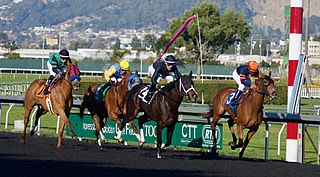
Horse racing is an equestrian performance sport, typically involving two or more horses ridden by jockeys over a set distance for competition. It is one of the most ancient of all sports, as its basic premise – to identify which of two or more horses is the fastest over a set course or distance – has been mostly unchanged since at least classical antiquity.

Horse racing is the second largest spectator sport in Great Britain, and one of the longest established, with a history dating back many centuries. According to a report by the British Horseracing Authority it generates £3.39 billion total direct and indirect expenditure in the British economy, of which £1.05 Billion is from core racing industry expenditure and the major horse racing events such as Royal Ascot and Cheltenham Festival are important dates in the British and international sporting and society calendar.

The Jockey Club is the largest commercial horse racing organisation in the United Kingdom. It owns 15 of Britain's famous racecourses, including Aintree, Cheltenham, Epsom Downs and both the Rowley Mile and July Course in Newmarket, amongst other horse racing assets such as the National Stud, and the property and land management company, Jockey Club Estates. The registered charity Racing Welfare is also a company limited by guarantee with the Jockey Club being the sole member. As it is governed by Royal Charter, all profits it makes are reinvested back into the sport.

Thoroughbred horse racing is an important spectator sport in Australia, and gambling on horse races is a very popular pastime with A$14.3 billion wagered in 2009/10 with bookmakers and the Totalisator Agency Board (TAB). The two forms of Thoroughbred horseracing in Australia are flat racing, and races over fences or hurdles in Victoria and South Australia. Thoroughbred racing is the third most attended spectator sport in Australia, behind Australian rules football and rugby league, with almost two million admissions to 360 registered racecourses throughout Australia in 2009/10. Horseracing commenced soon after European settlement, and is now well-appointed with automatic totalizators, starting gates and photo finish cameras on nearly all Australian racecourses.

Royal Randwick Racecourse is a racecourse for horse racing located in the Eastern Suburbs of Sydney, New South Wales. Randwick Racecourse is Crown Land leased to the Australian Turf Club and known to many Sydney racegoers as headquarters. The racecourse is located about six kilometres from the Sydney Central Business District in the suburb of Randwick. The course proper has a circumference of 2224m with a home straight of 410m.

Canterbury Park Racecourse is a racecourse for horse racing in Sydney, New South Wales, Australia. It is located 11 km (7 mi) from the Sydney Central Business District, in King Street in the suburb of Canterbury, adjacent to Canterbury railway station. The racecourse is operated by the Australian Turf Club.

A point-to-point is a form of horse racing over fences for hunting horses and amateur riders. In Ireland, where the sport is open to licensed professional trainers, many of the horses will appear in these races before they compete in National Hunt races. Consequently, the Irish point-to-point is more used as a nursery for future young stars: a horse that wins its debut point-to-point in Ireland will often sell for a high price. Whilst professional trainers are specifically excluded from running horses in point-to-points in Great Britain, the days of the farmer running his hunter at the local point-to-point have gone. Increasingly, horses are run from "livery yards" - unlicensed but otherwise professional training establishments, sometimes closely allied with a licensed yard.

The National Horseracing Authority of Southern Africa, known as the National Horseracing Authority for short, formerly the Jockey Club of Southern Africa is the Southern African equivalent of the American and British Jockey Clubs, whose main purposes are to prevent malpractice in horse racing and to regulate the thoroughbred horse racing industry in Southern Africa.
South Australian Jockey Club is the principal race club in South Australia.
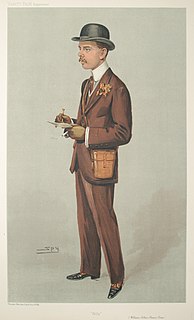
Sir William Arthur Hamar Bass, 2nd Baronet was a British racehorse owner and a significant contributor to the racing industry. He also provided support for the British film industry in its early days.

Going (UK), track condition (US) or track rating (AUS) are the track surface of a horse racing track prior to a horse race or race meet. The going is determined by the amount of moisture in the ground and is assessed by an official steward on the day of the race.
The Stewards' Cup is a Hong Kong Thoroughbred horse race held annually during the latter part of January at Sha Tin Racecourse. A Group One race that offers a purse of HK$12,000,000, it is run on turf over a distance of 1600 meters and is open to horses three years of age and older. The first leg of the Hong Kong Triple Crown, it is followed by the Hong Kong Gold Cup in February. and the Hong Kong Champions & Chater Cup in late May/early June.
Ngong Racecourse is a racecourse in Nairobi, Kenya. It is the main and currently only thoroughbred racing venue in Kenya. It is located along the Ngong Road near the Lenana School and next to The Nairobi Business Park, beside ngong forest. It is operated by the Jockey Club of Kenya.

Australian Turf Club (ATC) owns and operates thoroughbred racing, events and hospitality venues across Sydney, Australia. The ATC came into being on 7 February 2011 when the Australian Jockey Club (AJC) and the Sydney Turf Club (STC) merged. The ATC primarily operates out of their offices at Randwick Racecourse and employs approximately 270 full-time staff and over 1,000 casual staff across the five venues. The venues include Randwick, Rosehill Gardens, Canterbury Park, Warwick Farm and the Rosehill Bowling Club.
Patrick Joseph Prendergast (1910–1980), known as Paddy "Darkie" Prendergast was an Irish trainer of racehorses. He won seventeen Irish classics and became the first Irish trainer to have a major impact on British flat racing. He trained the first Irish winners of the 2000 Guineas and The Oaks and was British champion trainer for three successive seasons.
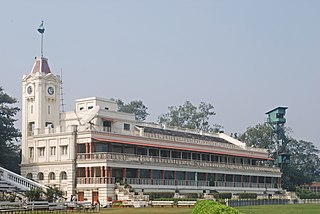
The Royal Calcutta Turf Club (RCTC) is a horse racing organisation which was founded in 1847 in Calcutta, British India. Horse events and sports were initially organised for the British cavalry at Akra before they were moved to the Maidan. The RCTC became the foremost horse-racing organization in India during the British Raj. At one time it was the governing body for nearly all racecourses in the subcontinent, defining and applying the rules governing the sport. During its heyday, RCTC-organised races were among the most important social events of the bigwigs' calendar and were opened by the Viceroy of India. Still a private club, the RCTC operates Kolkata Race Course in the Maidan.

Nuwara Eliya Racecourse in Nuwara Eliya, Sri Lanka is the only remaining horse racing venue in Sri Lanka. Situated 1,868 metres (6,129 ft) above sea level the race course is one of the highest in the world. The track has a circumference of 1,800 metres (5,900 ft) with a 333-metre straight.
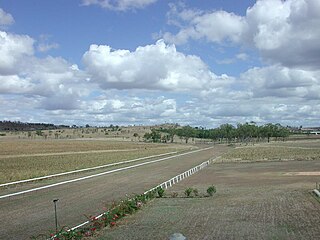
Gayndah Racecourse is a heritage-listed racecourse at Fisher Avenue, Gayndah, North Burnett Region, Queensland, Australia. It was built c. 1855. It is also known as Gayndah Race Track. It was added to the Queensland Heritage Register on 12 September 2005.
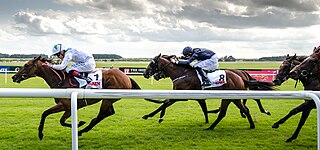
Horse racing in Ireland is intricately linked with Irish culture and society. The racing of horses has a long history on the island, being mentioned in some of the earliest texts. Domestically, racing is one of Ireland's most popular spectator sports, while on the international scene, Ireland is one of the strongest producers and trainers of Thoroughbred horses. The Irish horse racing industry is closely linked with that of Great Britain, with Irish horses regularly competing and winning on the British racing circuit.

Colwall Park Racecourse was a British horse racing venue which operated from 1900 to 1939. It was known as one of England’s prettiest racecourses.
References
A complete history of Pony Racing at Northolt.
Pitt,Chris: A long time gone (1996; rev.ed. 2006).